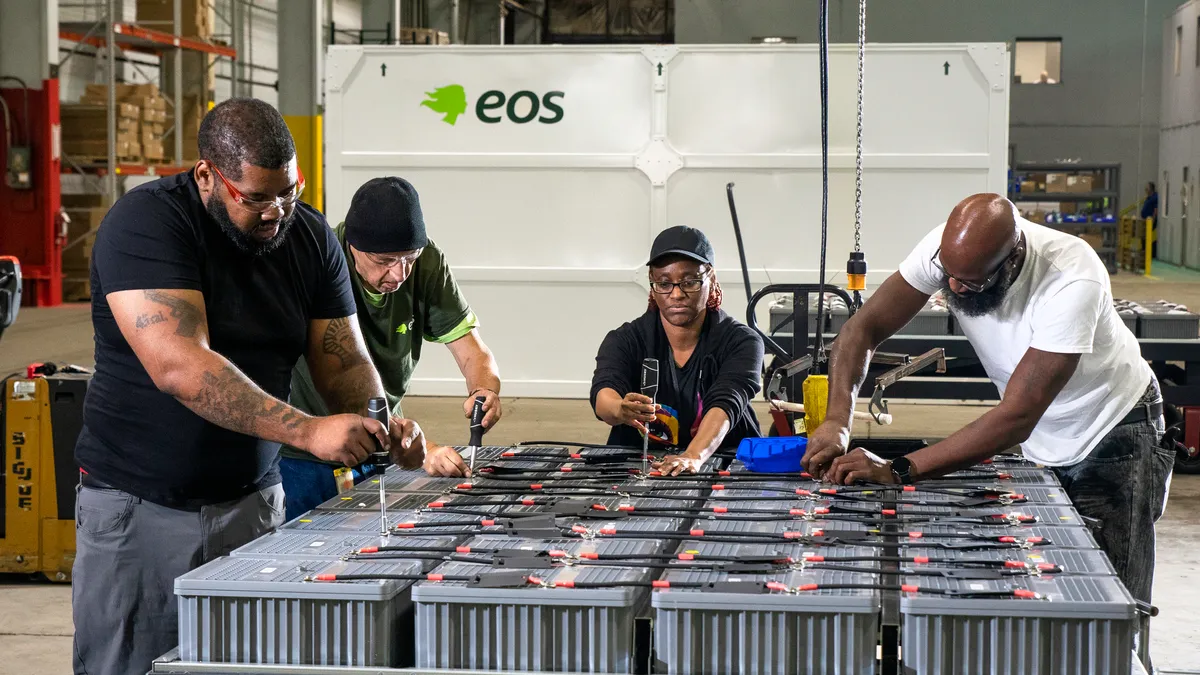Eos Energy Enterprises has landed an up to $398.6 million conditional loan guarantee from the Department of Energy to expand a manufacturing plant to mass produce zinc-powered long-duration energy storage systems.
If finalized, Eos expects to annually manufacture systems with a total of 8 GWh of storage capacity by 2026 at the plant in Turtle Creek, Pennsylvania, the Edison, New Jersey-based company said Thursday.
The pending loan guarantee would fund 80% of an expansion of a semi-automated production facility, which started commercial operations in early August. The expansion, dubbed Project AMAZE — American Made Zinc Energy, calls for building four high-output manufacturing lines that would produce batteries that can discharge for three to 12 hours.
The plant makes Eos’ Z3 battery, which contains mostly U.S. components, according to the company. Domestic production better positions Eos to access the 10% 45X advanced manufacturing direct pay tax credits available under the Inflation Reduction Act, the company said.
The batteries can achieve 100% depth of discharge and are rated for 6,000 charge/discharge cycles, or about 20 years of use, before they degrade, DOE said.
The Z3 batteries are expected to be more energy dense and cost-efficient to make than Eos’ previous models, DOE said.
Eos sacrificed a few points of round-trip efficiency in its zinc battery design compared to lithium-ion batteries, but the zinc batteries are safer with reduced fire risks, Eos CEO Joe Mastrangelo said during an Aug. 15 earnings conference call. Initial testing of the Z3 batteries had an up to 79% round-trip efficiency, according to the Eos presentation. Round trip efficiency is a measure of how much electricity that is stored can then be discharged.
In the power sector, companies have to show their products work in the field, not just in the laboratory, according to Mastrangelo.
“So we've got to get the Z3 out in the field operating on customer sites,” he said. “And at the same time, perfect what we're doing, then automate, then scale, and we're trying to do that in a very compressed cycle time.”
The IRA’s 10% domestic content bonus credit is a tailwind for bringing Z3 costs down, according to Nathan Kroeker, Eos chief financial officer.
“With our domestic content levels, we expect customers to see this benefit not only for their storage assets, but potentially in helping their overall projects to qualify for this added 10% credit,” he said.
Eos had a $9.7 billion, 37 GWh project pipeline in the second quarter, up $1.1 billion from the previous quarter, according to Kroeker. The pipeline includes $1.6 billion in signed letters of intent, representing more than 7 GWh, about 30% of them expected to become firm orders, he said.
Eos has orders with 13 customers worth $533.6 million for battery systems that can produce 2.2 GWh, according to Kroeker. Customers include utilities, project developers, independent power producers and industrial customers, he said, adding that more than half the backlog is in California Independent System Operator and Electric Reliability Council of Texas markets.
Eos has a contract to supply Bridgelink Commodities, a solar and storage developer, with 1 GWh of batteries, according to Kroeker.
Bridgelink management has told Eos that an affiliate reached a settlement with its lender on a loan, and the company is seeking financing for its pending projects, some of which have interconnection agreements, Kroeker noted.
Eos expects that a loan guarantee from DOE will increase customer confidence in its batteries and its ability to deliver long-duration energy storage projects, he said.
Meanwhile, DOE’s Loan Program Office was reviewing 157 applications seeking $138.9 billion in loans as of July, up from 77 applications looking for $80.8 billion in loans a year earlier. The office has about $215.5 billion in remaining loan authority across its programs.















